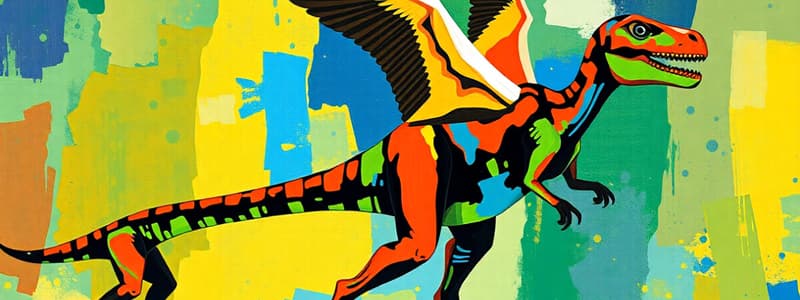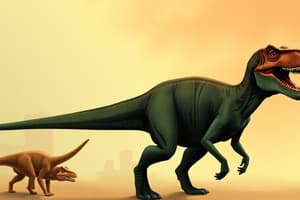Podcast
Questions and Answers
During which period did dinosaurs first appear?
During which period did dinosaurs first appear?
- Jurassic
- Paleogene
- Cretaceous
- Triassic (correct)
What major event allowed dinosaurs to become dominant terrestrial vertebrates?
What major event allowed dinosaurs to become dominant terrestrial vertebrates?
- Cretaceous–Paleogene extinction event
- Ordovician extinction event
- Triassic–Jurassic extinction event (correct)
- Permian mass extinction
What group do birds belong to within dinosaurs?
What group do birds belong to within dinosaurs?
- Reptilian dinosaurs
- Extinct dinosaurs
- Avian dinosaurs (correct)
- Non-avian dinosaurs
What misconception about dinosaurs was prevalent before the 1970s?
What misconception about dinosaurs was prevalent before the 1970s?
How many distinct genera of non-avian dinosaurs have paleontologists identified using fossil evidence?
How many distinct genera of non-avian dinosaurs have paleontologists identified using fossil evidence?
What adaptation is common among many dinosaur species in relation to their reproduction?
What adaptation is common among many dinosaur species in relation to their reproduction?
Which feature was NOT common among all dinosaur groups?
Which feature was NOT common among all dinosaur groups?
What characteristic is a typical feature of the largest sauropod dinosaurs?
What characteristic is a typical feature of the largest sauropod dinosaurs?
What is a major reason for the misconception that all non-avian dinosaurs were large?
What is a major reason for the misconception that all non-avian dinosaurs were large?
Who coined the term 'dinosaur'?
Who coined the term 'dinosaur'?
What type of dinosaur includes both herbivorous and carnivorous species?
What type of dinosaur includes both herbivorous and carnivorous species?
Which group of dinosaurs is defined as containing the last common ancestor of Triceratops and modern birds?
Which group of dinosaurs is defined as containing the last common ancestor of Triceratops and modern birds?
What recent finding by researchers suggested a change in traditional dinosaur systematics?
What recent finding by researchers suggested a change in traditional dinosaur systematics?
Which of the following groups does NOT belong to Dinosauria?
Which of the following groups does NOT belong to Dinosauria?
What definition did Baron et al. propose to include sauropods within dinosaurs?
What definition did Baron et al. propose to include sauropods within dinosaurs?
Which feature distinguishes Maniraptora within dinosaur classifications?
Which feature distinguishes Maniraptora within dinosaur classifications?
What is the primary reason for the public's ongoing interest and investment in dinosaur science?
What is the primary reason for the public's ongoing interest and investment in dinosaur science?
Which of the following characteristics pertains to Theropoda?
Which of the following characteristics pertains to Theropoda?
Flashcards
What are dinosaurs?
What are dinosaurs?
A diverse group of reptiles that first appeared during the Triassic period, between 243 and 233.23 million years ago.
When did dinosaurs become dominant?
When did dinosaurs become dominant?
Dinosaurs became the dominant land animals after the Triassic–Jurassic extinction event about 201.3 million years ago.
How are birds related to dinosaurs?
How are birds related to dinosaurs?
Birds evolved from a group of dinosaurs called theropods during the Late Jurassic epoch, making them the only surviving dinosaur lineage.
How do dinosaurs reproduce?
How do dinosaurs reproduce?
Signup and view all the flashcards
How did dinosaurs move?
How did dinosaurs move?
Signup and view all the flashcards
What features were common to dinosaurs?
What features were common to dinosaurs?
Signup and view all the flashcards
How active were dinosaurs?
How active were dinosaurs?
Signup and view all the flashcards
How big were dinosaurs?
How big were dinosaurs?
Signup and view all the flashcards
Dinosaurs (Phylogenetic Definition)
Dinosaurs (Phylogenetic Definition)
Signup and view all the flashcards
Dinosaur Origin
Dinosaur Origin
Signup and view all the flashcards
Dinosaur Size Misconception
Dinosaur Size Misconception
Signup and view all the flashcards
Fossil Preservation Bias
Fossil Preservation Bias
Signup and view all the flashcards
Dinosaur Name Origin
Dinosaur Name Origin
Signup and view all the flashcards
Dinosaur Museum Popularity
Dinosaur Museum Popularity
Signup and view all the flashcards
Dinosaurs (Alternative Phylogenetic Definition)
Dinosaurs (Alternative Phylogenetic Definition)
Signup and view all the flashcards
Ankylosaurians
Ankylosaurians
Signup and view all the flashcards
Stegosaurians
Stegosaurians
Signup and view all the flashcards
Birds are Dinosaurs
Birds are Dinosaurs
Signup and view all the flashcards
Study Notes
Dinosaur Overview
- Dinosaurs are a diverse group of reptiles from the clade Dinosauria.
- Their existence began during the Triassic period (243-233.23 million years ago). Ongoing research explores their exact origin and evolutionary timing.
- Dinosaurs became dominant terrestrial vertebrates post-Triassic–Jurassic extinction (201.3 million years ago).
- Birds are feathered dinosaurs, evolving from earlier theropods in the Late Jurassic and are the sole surviving dinosaur lineage.
- Dinosaurs are categorized into avian (birds) and extinct non-avian dinosaurs.
Dinosaur Diversity
- Dinosaurs display wide variety taxonomically, morphologically, and ecologically.
- Bird diversity stands out, with over 11,000 living species, representing a significant portion of vertebrate diversity.
- Paleontological evidence suggests over 900 genera and 1,000 species of non-avian dinosaurs.
- Dinosaur fossils are found on every continent, showcasing their global distribution.
- Historically, dinosaurs were perceived as sluggish and cold-blooded; however, modern research suggests they were active with elevated metabolisms and complex social behaviours.
- Dinosaur diets varied, with herbivorous and carnivorous species.
- All dinosaurs were egg-laying, and many built nests, a shared characteristic between avian and non-avian dinosaurs.
Dinosaur Morphology and Size
- Dinosaurs exhibited bipedal locomotion, although many extinct species were quadrupedal, with some capable of switching between stances.
- Common display features include horns and crests. Some groups evolved skeletal enhancements like bony armor and spines.
- Modern birds (avian dinosaurs) are generally smaller due to flight adaptation constraints.
- However, many prehistoric dinosaurs (avian and non-avian) were large-bodied, including the estimated 39.7-meter (130 ft) sauropods, the largest land animals ever.
- The misconception of uniform dinosaur gigantism is due to a preservation bias: large, robust bones are more likely to fossilize.
Dinosaur Discovery and Cultural Impact
- Dinosaur fossils were recognized in the early 19th century.
- The term "dinosaur," meaning "terrible lizard," was coined by Sir Richard Owen in 1842.
- Dinosaur skeletons are common museum exhibits.
- Dinosaurs have a prominent role in popular culture, especially through films like Jurassic Park.
- Public interest generates funding for further dinosaur research and contributes to media coverage of new discoveries.
Phylogenetic Definition and Classification
- Dinosaurs are defined phylogenetically as the group including the most recent common ancestor (MRCA) of Triceratops and modern birds, and all its descendants.
- Alternative definitions use the MRCA of Megalosaurus and Iguanodon.
- Dinosauria encompasses Ornithischia (e.g., ankylosaurians, stegosaurians, ceratopsians, pachycephalosaurians, ornithopods) and Saurischia (e.g., theropods, sauropodomorphs).
- Birds are the only surviving lineage of dinosaurs.
- Previously, birds were separated as a distinct class, but contemporary paleontology classifies them within the Dinosauria according to phylogenetic relationships.
- Birds belong to the dinosaur group Maniraptora (coelurosaurs, theropods, saurischians).
- Research from 2017 proposed a revision of dinosaurian systematics, suggesting Ornithischia is more closely related to Theropoda than Sauropodomorpha.
- This revised definition included sauropods and their relatives as dinosaurs in the clade, with a new clade, Ornithoscelida, suggested to encompass Ornithischia and Theropoda.
Studying That Suits You
Use AI to generate personalized quizzes and flashcards to suit your learning preferences.




